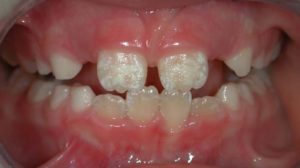 One of the common parents’ concerns when it comes to their child teeth is noticing white spots scattering on surface of the front teeth, most of the parents come with the idea that these white lesions are because of low level of calcium in the child body, however what are those lesions, and how can we prevent them from happening?
One of the common parents’ concerns when it comes to their child teeth is noticing white spots scattering on surface of the front teeth, most of the parents come with the idea that these white lesions are because of low level of calcium in the child body, however what are those lesions, and how can we prevent them from happening?
In scientific terms, these white lesions are called enamel hypo-mineralization. Enamel hypo-mineralization usually happened due to repeat exposure to bacteria acids in the child mouth which results in demineralization of the tooth enamel structure and subsurface porosity, and these considered as the first steps towards dental cavities.
During ingestion of food containing sugar such as flavoured milk, chocolate bar, or candies, the pH of the saliva immediately falls dramatically below the critical level of pH 5.5, in which the enamel (the outer surface of the tooth) will start to demineralize into ions, and because of the presence of saliva that can buffer the this low acidic environment and push it back above the critical level pH of 5.5 which results in remineralization of the tooth, and from that we now know that demineralization and remineralization are normal procedures that happens every time we eat.
However, with frequent ingestions of carbohydrates (more than 3 times daily) such as candies, or sweet lozenges and night feeding, demineralization will surpass the remineralization process and the outer surface of the tooth starts to loose it hard structure and the white spots will forms.
Enamel hypo-mineralization usually occur more between the posterior teeth, as these teeth usually more difficult to clean, and are missed during teeth brushing. Besides the morphology that retain food more easily at longer time. Enamel hypo-mineralization is an alarming sign as if left without treatment will eventually decay and form cavities within short period of time.
 While now we know what these white spots are in our children teeth, we should focus on how to manage them and prevent them from developing into cavities. One of the first thing the dentist will do is diet analysis, by which the dentist will ask the parents on their child daily diet intake. Parents are required to provide everything the child will be having for the next 3 days (2 weekdays, 1 weekend) to determine the type of food the child is consuming, type of snack the parents are providing for their children and the frequency of consumption. Once the diet analysis sheet is ready, then the dentist will give proper advice with the present of their children on the healthy diet intake they should practice every day. This because sometimes the parents are not aware about the amount of sugar hidden in food they eat every day such as ketchup, that could exaggerate the demineralization of their child teeth. After being educate on the healthy diet, the second step is to deal with these white lesions. The good news is these lesions are in reversible stage once the oral environment is above pH 5.5 the remineralization process will be higher than demineralization then these spot will disappear.
While now we know what these white spots are in our children teeth, we should focus on how to manage them and prevent them from developing into cavities. One of the first thing the dentist will do is diet analysis, by which the dentist will ask the parents on their child daily diet intake. Parents are required to provide everything the child will be having for the next 3 days (2 weekdays, 1 weekend) to determine the type of food the child is consuming, type of snack the parents are providing for their children and the frequency of consumption. Once the diet analysis sheet is ready, then the dentist will give proper advice with the present of their children on the healthy diet intake they should practice every day. This because sometimes the parents are not aware about the amount of sugar hidden in food they eat every day such as ketchup, that could exaggerate the demineralization of their child teeth. After being educate on the healthy diet, the second step is to deal with these white lesions. The good news is these lesions are in reversible stage once the oral environment is above pH 5.5 the remineralization process will be higher than demineralization then these spot will disappear.
Dentists usually apply fluoride varnish over the teeth regularly every 3 months (for child with higher risk) to enhance the chances of remineralization, as fluoride is very efficient and necessary in protecting our teeth. The dentist will also advise the parents to make sure that the child is brushing with fluoridated toothpaste under close supervision and help the child when necessary to make sure that the teeth are clean. It also advisable to ensure the child spit the fluoride toothpaste after brushing.
Going the extra miles for our patients, dentists usually offer dietary advise by asking the parents to prepare healthy snacks for the children like cheese and vegetables and fruits instead of sweets and chocolate bars and the best advise to be given is to give the teeth a rest of 2 hours between meals to make sure that our saliva pH has recovered and buffered above 5.5 critical value.
Dr Aws Hashim Ali Al-Kadhim, Dr Syafiq Alauddin, and Dr Azlan Jaafar are researchers and lecturers at Faculty of Dentistry, Univeristi Sains Islam Malaysia. Find out more about Dr Aws Hashim at our Columnists page.
